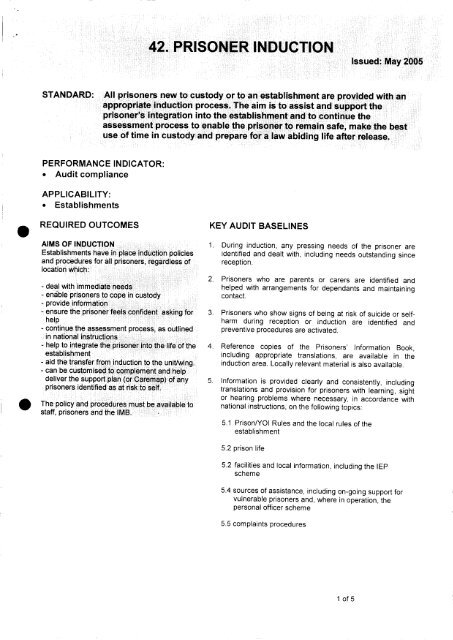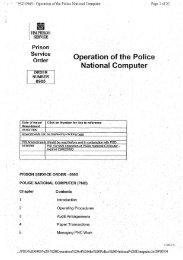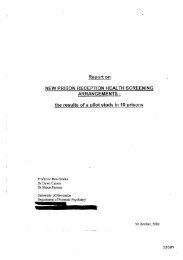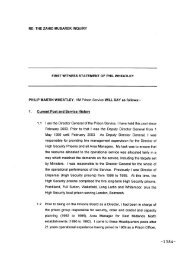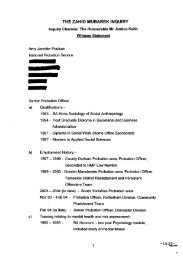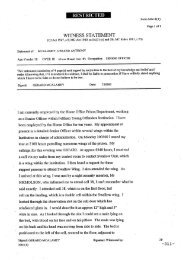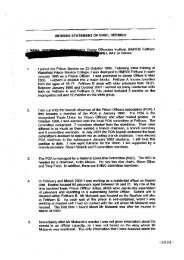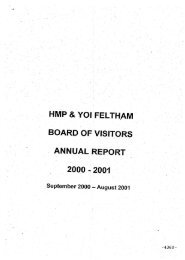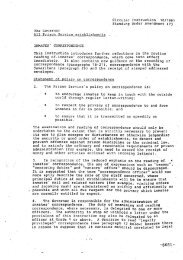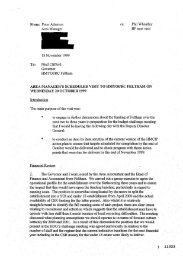42. PRISONER INDUCTION
42. PRISONER INDUCTION
42. PRISONER INDUCTION
You also want an ePaper? Increase the reach of your titles
YUMPU automatically turns print PDFs into web optimized ePapers that Google loves.
.=<br />
<strong>42.</strong> <strong>PRISONER</strong> <strong>INDUCTION</strong><br />
Issued: May 2005<br />
STANDARD: establishl led with an<br />
the<br />
pri<br />
use of time i<br />
g life after release.<br />
t<br />
PERFORMANCE INDICATOR:<br />
• Audit compliance<br />
APPLICABILITY:<br />
• Establishments<br />
REQUIRED OUTCOMES<br />
KEY AUDIT BASELINES<br />
1. During induction, any pressing needs of the prisoner are<br />
policies identified and dealt with, including needs outstanding since<br />
and procedures for all }of reception.<br />
2. Prisoners who are parents or caters are identified and<br />
helped with arrangements for dependants and maintaining<br />
- enable'pr sorters to contact.<br />
- provide infor_ati0n<br />
, ensure the<br />
i i iii!!iiil i<br />
3. Prisoners who show signs of being at risk of suicide or self-<br />
help ...... harm during reception or induction are identified and<br />
-COl .=Sasoutlined preventive procedures are activated.<br />
ihel 4. Reference copies of the Prisoners' Information Book,<br />
establishment including appropriate translations, are available in the<br />
- aid thei induction area. Locally relevant material is also available.<br />
deliver the suppc any 5. Information is provided clearly and consistently, including<br />
prisoners identified _ ..... translations and provision for prisoners with learning, sight<br />
..... or hearing problems where necessary, in accordance with<br />
The policy and<br />
national instructions, on the following topics:<br />
staff, ' elMB. .............<br />
5.1 Prison/YOI Rules and the local rules of the<br />
establishment<br />
5.2 prison life<br />
5.2 facilities and local information, including the IEP<br />
scheme<br />
5.4 sources of assistance, including on-going support for<br />
vulnerable prisoners and, where in operation, the<br />
personal officer scheme<br />
5.5 complaints procedures<br />
1 of 5
5.6 formal procedures, such as adjudication; early release;<br />
and deportation<br />
5.7 opportunities to learn skills and prepare for release<br />
5.8 bail information<br />
5.9 legal services<br />
5.10 preserving outside links and supportive factors<br />
5.11 CARATs<br />
5.12 How to access healthcare services.<br />
6. The Race Relations Policy and the Violence Reduction<br />
Strategy are explained in the induction programme,<br />
including what to do in the event of an incident, and the key<br />
principles are displayed in an area where prisoners on<br />
induction are likely to read them.<br />
7. Induction is a multi-disciplinary process. Arrangements are<br />
in place which bring together and co-ordinate the full range<br />
of required assessments. OASys/Sentence planning<br />
procedures are used where they apply. Prisoners must not<br />
be repeatedly asked the same questions. For young people<br />
under 18 years old/or serving a DTO, there is a formal<br />
consideration of ASSET to inform the sentence planning<br />
and review procedures; and a full education assessment in<br />
accordance with the National Specification for Leaming and<br />
Skills undertaken.<br />
8. Induction involves an assessment of prisoners' resettlement<br />
needs on release, including the need to protect existing<br />
housing and employment and a standard of skills which will<br />
increase employability Relevant information is provided to<br />
all prisoners, including sources of advice and assistance on:<br />
8.1 accommodation<br />
8.2 employment<br />
8.3 training, learning and skills<br />
8.4 benefits and other financial matters<br />
8.5 probation supervision<br />
8.6 release abroad.<br />
9. A record is maintained of the induction planned and<br />
provided for each prisoner. All staff requiring records of<br />
induction have ready access and make appropriate use of<br />
them.<br />
10. For young people under 18 years old and/or serving a D TO,<br />
there are arrangements to ensure, unless this is recorded<br />
as inappropriate, that the next of kin, is provided, w#hin 48<br />
hours of arnva/, with details of the following:<br />
2 of 5
10.1 visiting arrangements<br />
10.2 personal property<br />
10.3 pastoral care<br />
10.4 date of initial Training Plan meeting.<br />
Provision of this information is recorded in the trainee.'s<br />
F2052A.<br />
TRANSITION BETWEEN THE RECEPTION<br />
AND <strong>INDUCTION</strong> PROCESSES<br />
11. Information about individual prisoners is transferred from the<br />
Governorsensurethat effectivecommunication reception to the induction stages, including specific risks<br />
systemsoperate betweenthe receptionand<br />
and needs identified, action taken, outstanding action points<br />
inductionprocessesso that any relevant and any concerns. Missing information from previous<br />
informationis passedon.<br />
establishments is followed up.<br />
O<br />
Once the receptionprocess hasfinished,<br />
prisonersare classedas being onthe induction<br />
process,even ifthey have notyet starteda formal<br />
programme,untilthey have completedit.<br />
12. Arrangements are in operation to assist prisoners arriving<br />
late or at weekends.<br />
13. If there is a delay (which must be as short as possible)<br />
before the formal induction programme begins,<br />
arrangements are made to deal with prisoners' urgent or<br />
immediate induction needs.<br />
14. Young people under 18 years old and/or serving a<br />
Detention and Training Order (DTO) are providecl with<br />
writing materials and where necessary given a Pin Phone<br />
credit to facilitate contact with their family. Provision of these<br />
facilities is recorded in the trainee's F2052A.<br />
FIRST NIGHT<br />
Arra_ :he safety 15. Information, including written information and relevant<br />
;ularly during translation, is provided to prisoners about what they need to<br />
the first nght n custody know and what will happen in the first 24 hours.<br />
16. Prisoners receive information on getting help, eg, contacting<br />
a member of staff, prisoner Listener, Insider and Buddy<br />
schemes and Samaritans.<br />
17. On transfer to the allocated wing/unit, prisoners are given<br />
information on wing and other routines and names of key<br />
staff members, including, where in operation, their personal<br />
officer.<br />
18. Young people under 18 years old and serving a DTO are<br />
offered the opportunity, within two hours of arrival, to<br />
telephone someone who may be concerned about their well<br />
being, if such communication has not been made in<br />
Reception. The outcome of this offer is recorded in the<br />
trainee's F2052A.<br />
3 of 5
19. The induction process assesses and is responsive to the<br />
individual needs of all prisoners as outlined in national<br />
instructions, eg, in relation to convicted and unconvicted<br />
prisoners; men and women; juveniles foreign nationals;<br />
different religious and cultural groups; those who cannot<br />
read and/or speak English; those located in the health care<br />
centre; those experiencing drug withdrawal; those with<br />
severe mobility problems and those identified as at risk of<br />
suicide or self harm.<br />
20. Potential, newly convicted and recalled lifers receive the<br />
same or an equivalent induction to other prisoners, with<br />
additional sessions to provide information about the life<br />
sentence process. Lifers are provided with a copy of the<br />
Lifer Information Book during the induction process, and<br />
particular care is taken to manage the high risk of suicide or<br />
self harm of this group.<br />
O 21. For young people under 18 years old and serving a DTO,<br />
the induction is of at least one week's duration, unless the<br />
young person has been placed m the establishment in the<br />
last 3 months, or no big changes have occurred since their<br />
last induction.<br />
22. Rooms are well maintained and comfortable, with suitable<br />
furniture in good repair.<br />
23. Provision is made for prisoners to have access to radios<br />
(where no television is available) in cell throughout the<br />
induction period to provide an important source of diversion<br />
and help them to settle.<br />
STAFFING, MANAGEMENT AND<br />
EVALUATION OFTHE<strong>INDUCTION</strong> 24. Staff working in induction have appropriate skills and<br />
PROCESS<br />
experience.<br />
Inductionstaffare aware of theirresponsibilities<br />
and competentto carry,them out. (Please see the 25. All relevant departments and outside agencies contribute to<br />
PrisonerInductionGuidanceforfurther<br />
induction.<br />
information.)<br />
26. Procedures are in place to obtain feedback from prisoners<br />
Management is activelyinvolvedinthe induction about their induction.<br />
processand ensures continuityof staffand<br />
consistencyof delivery.<br />
27. At the end of the reduction, a young person under 18 years<br />
old and/or serving a DTO is provided with a copy of the key<br />
features of their sentence plan and the daily and weekly<br />
timetable of activities in which they will be engaged.<br />
28. Prisoner Induction policy and procedures are reviewed by<br />
the Resettlement Policy Committee at least once a year.<br />
4of5
fa<br />
REFERENCES:<br />
LEGISLATION<br />
Disability DiscriminationAct 1995<br />
Race Relations (Amendment) Act 2000<br />
Prison Rule 5 and Prison Rule 7 (2)<br />
YOI Rule 3 (1)<br />
Prison Rule 10 and YOI Rule 7<br />
NATIONAL INSTRUCTIONS<br />
PSO 0200 HM Prison Service standards manual<br />
PSO 0400 Prisoners' Information Books<br />
PSO 0500 Reception<br />
PSO 0550 Induction<br />
PSO 0900 Categorisation<br />
PSO 2205 Offender Assessment and Sentence Management - OASys<br />
PSO 2300 Resettlement<br />
PSO 2605 Role of the legal services officer<br />
PSO 2700 Suicide and Self-harm Prevention<br />
PSO 2750 Violence Reduction<br />
PSO 2800 Race relations<br />
PSO 2855 The management of prisonerswith physical, sensory and mental disabilities<br />
PSO 4000 Incentives and earned privileges. Earned communityvisits and compacts<br />
PSO 4250 Physical education<br />
PSO 4405 Assisted Prison Visits Scheme<br />
PSO 4600 Unconvicted, Unsentenced and Civil Prisoners<br />
PSO 4700 Lifer manual<br />
PSO 4801 The management of mother and baby unitsand the application process<br />
PSO 4950 Regimes for Juveniles<br />
PSO 6100 The bail system<br />
PSO 6101 Bail information schemes<br />
OTHER<br />
Safer Custody Group publications<br />
5 of 5


